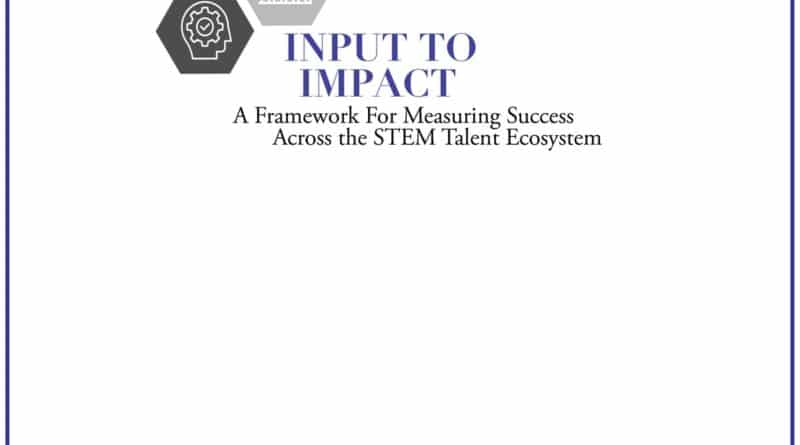Input to Impact: A Framework for Measuring Success Across the STEM Ecosystem
A recent report encourages corporate and philanthropic organizations to invest in high school and college STEM programs, and proposes a framework to help define and measure those investments’ impact.
In particular, if companies are seeking “short-term talent acquisition and development success,” wrote report author Erin White, head of product development and research for the organization, “they need to invest in postsecondary areas.” If it’s long-term results they’re seeking, then K-12 should be their focus, she noted.
The thinking is this: Unless a company has jobs for recent high school graduates or offers apprenticeship programs for those students (both of which would address short-term STEM talent outcomes), it needs to think longer term and look at high school and earlier grades as a “stepping stone” to college education. For example, a company might choose “to introduce middle schoolers to role models in STEM who come from similar racial or ethnic backgrounds.”
During both high school and college years, the emphasis should be on “enhancing skills, interest and confidence of potential future talent,” and helping to provide “STEM-rich learning environments, mentors and other opportunities.”
There are plenty of reasons why corporations would want to engage in these activities, White wrote — particularly for “positive corporate brand and strategic positioning benefits,” including community goodwill, differentiation from the competition and generating affinity among consumers.
The impacts of companies’ investments can be measured in terms of outputs and outcomes. The former covers what can be counted, such as dollars and employee hours invested, number of students that participated and their demographics. The latter encompasses a measurement of change, whether in individuals (such as their level of awareness, interest and knowledge), systems (such as fidelity to best practices) or “forces” (aspects that are beyond the direct control of companies or schools, such as policy or the macroeconomy).
Success overall, White proposed, could be measured by increased diversity in talent, the fostering of a more inclusive STEM ecosystem and improvement in collaboration across sectors and organizations.
“What we measure in STEM talent matters,” concluded the report. “It matters to corporations who have the opportunity to innovate products and services and contribute to the economic engine of society if they can tap into a diverse, skilled STEM workforce. It matters to educators of all levels who seek to contribute to the future success of their students. It matters most of all to the individual students, jobseekers and employees who seek out the opportunity to contribute to and benefit from the exponential economic and social value created by STEM.
The full report, “Input to Impact: A Framework for Measuring Success Across the STEM Ecosystem,” is available with registration on the STEMconnector website.
STEMconnector’s network of leading executives are asking important questions in boardrooms, classrooms, and communities:
- How will I know I’m successful in my investments and activities around STEM talent, from K-12 through postsecondary and into the workforce?
- As an employer, how do I assess both business value and social impact through measurement of these efforts?
- Which measures are most often used to assess progress towards STEM talent goals – and which should be used more often?
STEMconnector’s latest research report entitled Input to Impact: A Framework for Measuring Success Across the STEM Ecosystem helps answer these questions.
Input to Impact provides a common definition for success and a framework for measurement that can be used to plan and target STEM talent investments for greater impact, and measure progress towards goals. For those already engaged in STEM talent investments, this report provides a framework to assess the impact of existing work and improve returns.
Input to Impact builds off the findings of State of STEM, STEMconnector’s report providing a comprehensive view of the STEM talent ecosystem and of the challenges and opportunities within the ecosystem.

